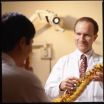Oldest horned dinosaur species in North America found in Montana
Hooked beak, sharply pointed cheeks distinguishes neoceratopsian species
2014-12-10
(Press-News.org) Scientists have named the first definite horned dinosaur species from the Early Cretaceous in North America, according to a study published December 10, 2014 in the open-access journal PLOS ONE by Andrew Farke from Raymond M. Alf Museum of Paleontology and colleagues.
The limited fossil record for neoceratopsian--or horned dinosaurs--from the Early Cretaceous in North America restricts scientists' ability to reconstruct the early evolution of this group. The authors of this study have discovered a dinosaur skull in Montana that represents the first horned dinosaur from the North American Early Cretaceous that they can identify to the species level. The authors named the dinosaur Aquilops americanus, which exhibits definitive neoceratopsian features and is closely related to similar species in Asia. The skull is comparatively small, measuring 84 mm long, and is distinguished by several features, including a strongly hooked rostral bone, or beak-like structure, and an elongated and sharply pointed cavity over the cheek region. When alive, the authors estimate it was about the size of a crow.
This discovery, combined with neoceratopsian fossil records from elsewhere, allows the authors to support a late Early Cretaceous (~113-105 million years ago) intercontinental migratory event between Asia and North America, as well as support for a complex set of migratory events for organisms between North America and Asia later in the Cretaceous. However, to better reconstruct the timing and mode of these events, additional fieldwork will be necessary.
"Aquilops lived nearly 20 million years before the next oldest horned dinosaur named from North America," said Andrew Farke. "Even so, we were surprised that it was more closely related to Asian animals than those from North America."
INFORMATION:
In your coverage please use this URL to provide access to the freely available paper: http://dx.plos.org/10.1371/journal.pone.0112055
Citation: Farke AA, Maxwell WD, Cifelli RL, Wedel MJ (2014) A Ceratopsian Dinosaur from the Lower Cretaceous of Western North America, and the Biogeography of Neoceratopsia. PLoS ONE 9(12): e112055. doi:10.1371/journal.pone.0112055
Funding: Funding was received from the National Science Foundation (DEB 9401094, 9870173, http://www.nsf.gov); National Geographic Society (5918-97, http://www.nationalgeographic.com/); and American Chemical Society (PRF #38572-AC8, http://www.acs.org). The funders had no role in study design, data collection and analysis, decision to publish, or preparation of the manuscript.
Competing Interests: Andrew A. Farke has read the journal's policy and the authors of this manuscript have the following competing interests: Andrew A. Farke is a volunteer section editor and academic editor for PLOS ONE. This does not alter the authors' adherence to PLOS ONE policies on sharing data and materials.
[Attachments] See images for this press release:


ELSE PRESS RELEASES FROM THIS DATE:
2014-12-10
Nearly 269,000 tons of plastic pollution may be floating in the world's oceans, according to a study published December 10, 2014 in the open-access journal PLOS ONE by Marcus Eriksen from Five Gyres Institute and colleagues.
Microplastic pollution is found in varying concentrations throughout the oceans, but estimates of the global abundance and weight of floating plastics, both micro and macroplastic, lack sufficient data to support them. To better estimate the total number of plastic particles and their weight floating in the world's oceans, scientists from six countries ...
2014-12-10
ANN ARBOR--As if holiday travel isn't stressful enough. Now University of Michigan researchers say we're likely sharing that already overcrowded airline cabin with countless tiny creatures including house dust mites.
"What people might not realize when they board a plane is that they can share the flight with a myriad of microscopic passengers-- including house dust mites--that take advantage of humanity's technological progress for their own benefit," said U-M biologist Pavel Klimov.
"House dust mites can easily travel on an airline passenger's clothes, skin, food ...
2014-12-10
Massachusetts General Hospital (MGH) investigators have identified two compounds that appear, in cellular and animal models, to block the cardiac damage caused by the important chemotherapy drug doxorubicin. Their report in the Dec. 10 issue of Science Translational Medicine indicates that inhibiting the action of an enzyme that is key to the generation of cellular energy in mitochondria could prevent doxorubicin-induced damage to cardiac cells without reducing the drug's anti-tumor effects.
"Doxorubicin-induced cardiomyopathy limits the amount of the drug a patient ...
2014-12-10
Treating the potentially blinding haze of a scar on the cornea might be as straightforward as growing stem cells from a tiny biopsy of the patient's undamaged eye and then placing them on the injury site, according to mouse model experiments conducted by researchers at the University of Pittsburgh School of Medicine. The findings, published today in Science Translational Medicine, could one day rescue vision for millions of people worldwide and decrease the need for corneal transplants.
According to the National Eye Institute, part of the National Institutes of Heath, ...
2014-12-10
Rats that received thyroid hormones had a reduced risk for dangerous heart arrhythmias following a heart attack, according to a new study by a team of medical researchers at New York Institute of Technology.
In the NIH-funded study, published in the Journal of Cardiac Failure, the team found that thyroid hormone replacement therapy significantly reduced the incidence of atrial fibrillation - a specific kind of irregular heartbeat, or arrhythmia -- in the rats, compared to a control group that did not receive the hormones.
The finding could have important implications ...
2014-12-10
San Diego, Calif., Dec. 10, 2014 -- Engineers at the University of California, San Diego have demonstrated a new and more efficient way to trap light, using a phenomenon called bound states in the continuum (BIC) that was first proposed in the early days of quantum wave mechanics.
Boubacar Kanté, an assistant professor in electrical and computer engineering at UC San Diego Jacobs School of Engineering, and his postdoctoral researcher Thomas Lepetit described their BIC experiment online in the rapid communication section of journal Physical Review B. The study directly ...
2014-12-10
Researchers from North Carolina State University and Qatar University have developed a new "high-entropy" metal alloy that has a higher strength-to-weight ratio than any other existing metal material.
High-entropy alloys are materials that consist of five or more metals in approximately equal amounts. These alloys are currently the focus of significant attention in materials science and engineering because they can have desirable properties.
The NC State research team combined lithium, magnesium, titanium, aluminum and scandium to make a nanocrystalline high-entropy ...
2014-12-10
Is it the thought that really counts?
When it comes to giving gift cards, maybe not.
New research from the University of Cincinnati can help even the most thoughtful gift giver avoid the mistake of over-personalization and keep that card from being banished to the bottom of a purse or hidden deep inside a wallet for the next six months.
"Givers often fail to anticipate that the gifts they prefer to give are not necessarily the ones recipients prefer to receive," says Mary Steffel, researcher and assistant professor of marketing in UC's Carl H. Lindner College of Business.
So ...
2014-12-10
CORVALLIS, Ore. - Researchers for the first time have developed a method to track through the human body the movement of polycyclic aromatic hydrocarbons, or PAHs, as extraordinarily tiny amounts of these potential carcinogens are biologically processed and eliminated.
PAHs, which are the product of the incomplete combustion of carbon, have been a part of everyday human life since cave dwellers first roasted meat on an open fire. More sophisticated forms of exposure now range from smoked cheese to automobile air pollution, cigarettes, a ham sandwich and public drinking ...
2014-12-10
Many children who sustain so-called open bone fractures in the forearm or lower leg can, and do, heal safely without surgery, according to the results of a small study led by investigators at the Johns Hopkins Children's Center.
Open fractures occur when the broken bone protrudes through the skin, causing a puncture wound.
The study, published ahead of print in the Journal of Children's Orthopaedics, shows that when the wound is small -- less ½-inch in diameter -- and the surrounding tissue is free of visible contamination with dirt or debris, children heal well ...
LAST 30 PRESS RELEASES:
[Press-News.org] Oldest horned dinosaur species in North America found in Montana
Hooked beak, sharply pointed cheeks distinguishes neoceratopsian species





